#yomiuri shimbun
Explore tagged Tumblr posts
Text

From: Onchi. A Poet of Colors and Forms, Yomiuri Shimbun, Tokyo, 1994 [BOOKS at, Amsterdam]
Exhibition: Yokohama Museum of Art, Yokohama, October 8 – November 6, 1994
#graphic design#art#drawing#photography#exhibition#catalogue#catalog#onchi kōshirō#koshiro onchi#yomiuri shimbun#yokohama museum of art#1990s
122 notes
·
View notes
Text
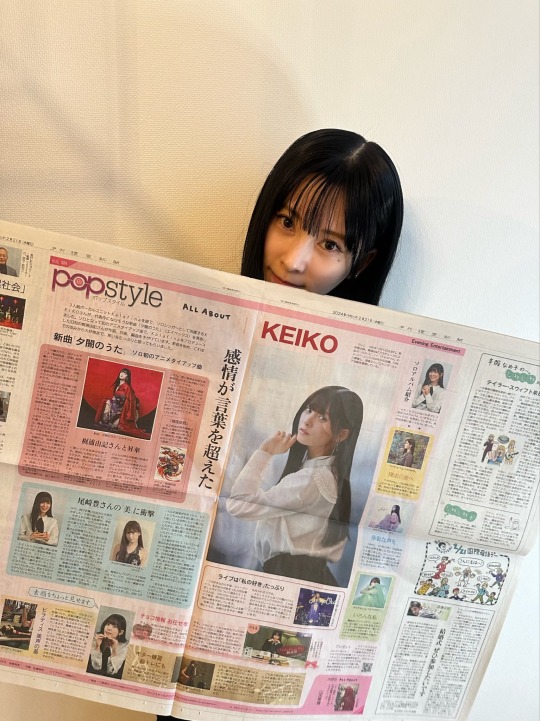
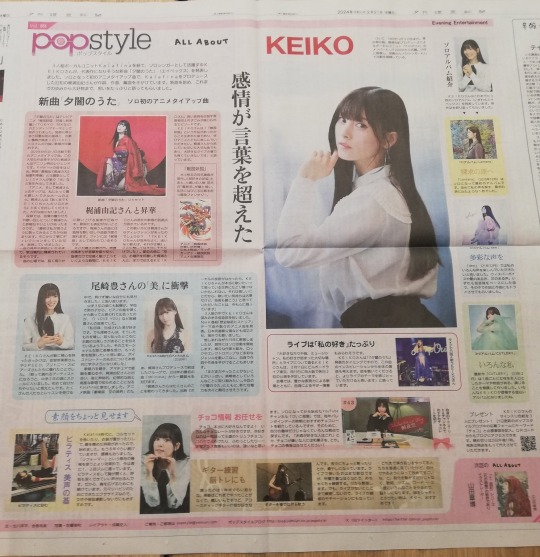

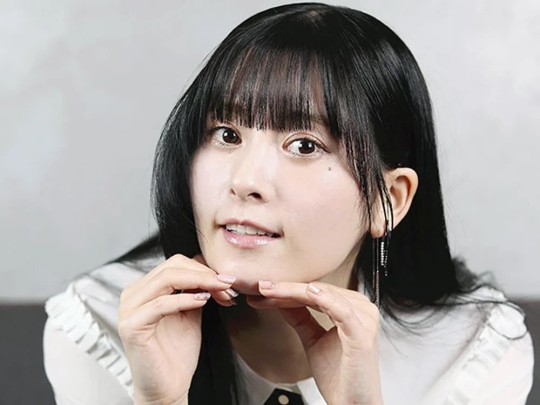
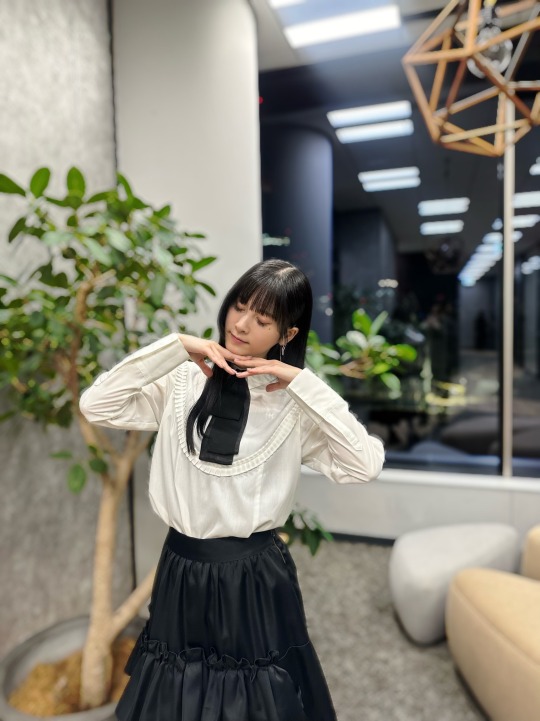
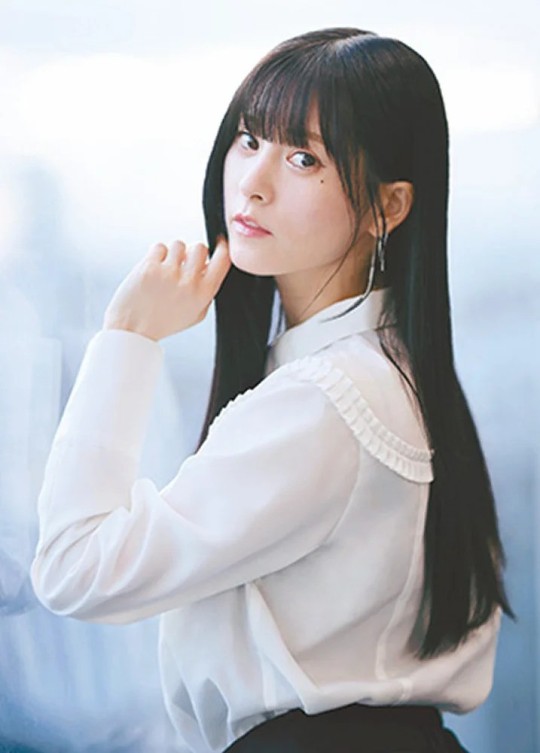
Keiko's Feature in Today's Yomiuri Shimbun (Popstyle)
Today's issue (Feb 21) of the daily newspaper Yomiuri Shimbun contains a 2-page feature about Keiko. Tweet 1 | Tweet 2 | Tweet 3 | KEIKO Instagram Story There's nothing particularly exciting here but I am glad one of my acquaintances in Japan got me a copy.
Update: Here you can find the digital version of the article!
Yuki Kajiura LIVE vol.#20~Japanese Seal 20th Special~
We also got details for Yuki Kajiura Vol.#20 this summer. The tour is titled "Special Japanese Seal" which means that no Japanese songs will be performed. That's a bit surprising actually since many people speculated that the next tour would feature a lot of Kara no Kyokai songs since none of them made it onto the Kaji Fes. setlists. Oh well, this will still be interesting. Expect a lot of Kajiurago and English tracks in the setlist. Please note though that the exclusion of Japanese songs does not apply to the encore section.
Yuki Kajiura LIVE vol.#20~日本語封印20th Special~
2024.06.02 Tokyo・SWU Hitomi Memorial Hall 16:45/17:30 2024.06.09 Kanagawa・Kenmin Hall 16:45/17:30 2024.06.23 Tokyo・LINE CUBE SHIBUYA 16:15/17:00 2024.06.29 Osaka・NHK Osaka Hall 17:15/18:00 2024.06.30 Osaka・NHK Osaka Hall 15:15/16:00 2024.07.06 Aichi・Niterra Shimin Hall 17:15/18:00 2024.08.03 Saitama・Sonic City Civiv Hall 17:15/18:00
【Appearing artists】 Yuki Kajiura(Piano/Chorus) Vocal:KAORI・KEIKO・YURIKO KAIDA・Joelle / rito・LINO LEIA Guest Vocal:Eri Ito
【Ticket price】 All seats assigned:¥8,800
FC Ticket Lottery:2024/3/1 15:00~3/10 23:59
URL: https://fictionjunctionstation.com/contents/ticket
#kalafina#keiko#news#media appearance#newspaper appearance#Yomiuri Shimbun#夕闇のうた#Yūyami no Uta#ykl vol 20#yuki kajiura#kajiura yuki#fictionjunction
26 notes
·
View notes
Text
Morre Watanabe Tsuneo, editor-chefe do Yomiuri Shimbun, aos 98
Tóquio, Japão, 20 de dezembro de 2024 (NHK) – Watanabe Tsuneo, figura de destaque no jornalismo japonês, faleceu aos 98 anos devido a complicações de pneumonia. A informação foi confirmada pelo Yomiuri Shimbun, um dos jornais mais influentes do Japão, onde Watanabe desempenhou papéis de liderança por décadas. Nascido em 1926, na capital japonesa, Watanabe iniciou sua carreira no Yomiuri Shimbun…
#editor-chefe#esportes no Japão#jornalismo japonês#política no Japão#Watanabe Tsuneo#Yomiuri Giants#Yomiuri Shimbun
0 notes
Text
The Yomiuri Shimbun 7:00 JST, July 9, 2023
In the aftermath of the fatal shooting of former Prime Minister Shinzo Abe one year ago on Saturday, attention was focused on the Unification Church, officially known as the Family Federation for World Peace and Unification, and the suffering endured by children of followers of the faith.
The alleged assailant of Abe was one of these “second-generation followers,” whose lives were left in tatters by the excessive donations made by their parents and the abuse they suffered in the name of religion.
They finally have had their voices heard, and are receiving expanded support from the public. But for many, the anguish is far from over.
A man in Aichi Prefecture still agonizes even though his mother purportedly left the Unification Church. “It seems her heart has not yet left the faith,” he says. “It’s really difficult to completely break from the church,” said the man who is in his 30s.
After the Abe shooting, he convinced his mother, who is in her 60s, to leave the Unification Church. Or so he thought. He suspects that she still maintains ties with the organization.
His mother had joined the church before he was born. She purchased expensive vases from the church, leading to frequent arguments with her husband. When the man was in elementary school, she went alone to South Korea, where the general headquarters of the Unification Church is located, to take part in a ceremony.
She would purloin his New Year’s gift money, and took out high-interest loans from consumer finance companies to make donations totaling over ¥15 million.
After Abe’s death, it came to light that defendant Tetsuya Yamagami, 42, held a grudge against the Unification Church, stating that his mother had bankrupted the family by contributing over ¥100 million to it. Yamagami said he targeted Abe because of his alleged links to the church.
“It’s the same as us,” the Aichi man thought when he heard Yamagami’s words.
The man and his younger brother confronted their mother and pushed her to leave the organization, saying, “It’s not so far-fetched that we end up [like Yamagami].” The mother resisted, saying, “The church is not bad,” but eventually gave in and submitted an official notice of quitting the church.
The man insisted that she request that the church return the funds she had paid, but she only got back ¥50,000. Believing it was far from enough, he pressed her to sue for a larger amount, but she refused.
A look at the call log on his mother’s mobile phone revealed contacts with an individual linked to the Unification Church. He brought up the news of people suffering because of excessive donations to the church and urged her to cut all contact, but said she ignored him.
Recently, she has been deleting her call history and hiding her phone, and he cannot confirm whether she has severed ties or not. “I have no idea how to fix this problem,” he says.
A letter with no reply “We can’t go back to the life we had before she got involved with the cult,” says a woman in the Kanto region struggling with her relationship with her mother.
In the Kanto region, a woman in her 50s had long struggled with whether to get her mother to leave the Unification Church. The answer still eludes her.
In 1973, her older brother, who was 5 at the time, was killed in an accident. Devastated by the loss, her mother turned to the Unification Church, and made donations over the years totaling at least ¥20 million.
Initially, the woman, her father and younger sister exhorted her mother to leave the organization, but she steadfastly refused. The father and sister eventually gave up, but the woman persisted.
The conflict led to a rift between the woman and her family, and she hasn’t seen them for about five years. Her father passed away three years ago, but she was only informed after the funeral. The woman became increasingly isolated, and finally gave up on convincing her mother.
After Abe was shot, the woman considered trying again, but the fear of rejection remained and time had passed. “Even so, I want her to be aware of the problems of the church,” she thought as she had a change of heart.
In late June, with the one-year anniversary of the shooting approaching, she sent her mother a letter for the first time.
“No matter how much time passes, my impression of the Unification Church will not change. Is there any salvation in a religion that pushes people to such extremes?”
There has been no reply.
_________________________________
Many Japanese women in Korea divorced and returned to Japan with their children in a state of deep dismay
_________________________________
Editorial: 1 year on from Abe's murder, let us renew our resolve to protect democracy July 8, 2023 (Mainichi Japan)
Japanese version
0 notes
Text
Picked up today’s editions of the Mainichi Shimbun, Asahi Shimbun, and the Yomiuri Shimbun



And they’re stunning. Huge. Beautiful. Incredible quality considering they’re newspapers. I can’t wait to get them framed and on the wall!
#jjk#jujutsu kaisen#nanami kento#gojo satoru#choso kamo#jjk nanami#jjk gojo#jjk choso#jjk vol 29#jjk vol 30#jjk final volume#jjk manga#jjk official art
92 notes
·
View notes
Text




Thom pictured in the Yomiuri Shimbun and the Asahi Shimbun for the release of Kid A.
Thanks to OAS on Twitter for the pictures.
81 notes
·
View notes
Text

lewis hamilton speaks to journalists after qualifying, japan - april 6, 2024 📷 the yomiuri shimbun / apimages.com
#lewis hamilton#f1#formula 1#japanese gp 2024#fic ref#fic ref 2024#japan#japan 2024#japan 2024 saturday
74 notes
·
View notes
Text





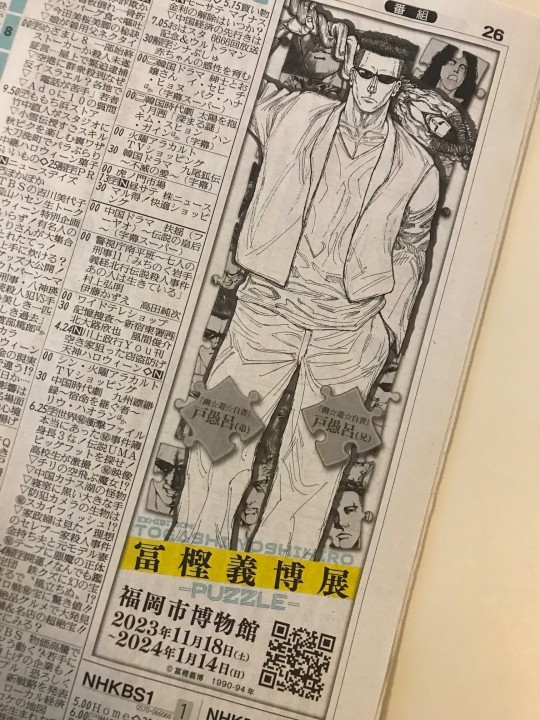
Yoshihiro Togashi Exhibition (Fukuoka Venue) Commemorative Project
13 Yoshihiro Togashi characters from Yu Yu Hakusho, Level E and HunterxHunter have appeared in the TV section of the Fukuoka Morning Edition of "Yomiuri Shimbun" newspaper. As for Yu Yu Hakusho, we have clippings of Yusuke, Kuwabara, Hiei, Kurama, Botan/Koenma, and the Toguro Brothers.
Puzzle Official Twitter has been sharing these newspaper clippings and holding the following campaign: "if the number of likes and reposts of the clipping reaches 10,000, we will give away wallpapers". As this number have already been reached, here's Yu Yu Hakusho Wallpaper:
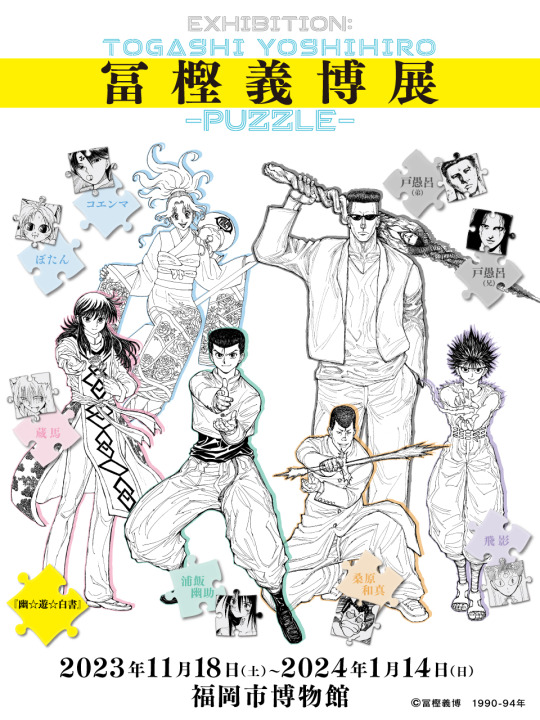
Source: Yoshihiro Togashi Exhibition Official Twitter
For more clippings and wallpapers from Togashi's other series (Level E and HxH), stay tuned on their Twitter!
#Yoshihiro Togashi Exhibition#fukuoka venue#yu yu hakusho#yusuke urameshi#kazuma kuwabara#hiei#kurama#botan#koenma#toguro brothers
122 notes
·
View notes
Text
I was listening to this cast by The Weeb Crew, with SteveM as a guest, going through some other Evangelion video and dissecting the mythical memetic tropes it buys into. Which was a lot of fun, I recommend the cast, and the video they are critiquing is a bit of a grad-bag of zombie memes about Evangelion from the 2000's, which yeah have aged poorly.
One of the ones they get into is the idea that Evangelion's TV ending was "intensely unpopular", and Anno & crew were getting like bombarded with death threats and stuff. Which happened at some level sure, but certainly wasn't the median response. The video actually sites the "emails" shown on screen in End of Evangelion as evidence:
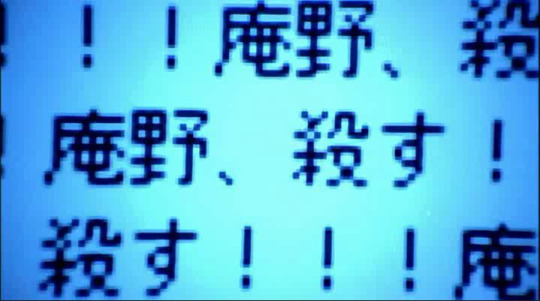
And like, bro those emails are fake! The staff wrote them for the movie, they didn't use real death threats or fan mail, that would be a huge legal liability. Not saying they are analytically useless or anything but, you know, you need to know that.
Anyway, SteveM mentions that of course there was pushback against Eva's ending, but actually the big wave wasn't interior to the fandom - instead it was sparked by Eva "going mainstream" discourse-wise. In particular a review essay by social critic Eiji Otuska (who is also a former lolicon creator ding ding ding) that was published after the finale aired sparked a widespread discussion in the media by other critics. He links to the essay in their discussion....except he doesn't. He thinks he did, and then when they look, its just someone else mentioning it in an article in 2003:
Bitter disputes broke out on online bulletin boards, with some critical of the producers for failing to provide a clear-cut end to the story, and others who praised the finish for being "typically Evangelion-like." But when commentator Eiji Otsuka sent a letter to the Yomiuri Shimbun, complaining about the end of the Evangelion series, the debate went nationwide. "The debate that erupted over the ending went way beyond our calculations," Gainax's Sato chuckles. "Anno probably knew what was going on. He realized that media other than anime had taken notice of Evangelion."
Which triggered in me the thought - why doesn't he have it? He references it in his own work after all. As you can guess, after some searching I am pretty sure I know why; no one has it. Its never been scanned or reprinted in an accessible format! It definitely is important in the history of Evangelion - I have seen this claim in other contexts, the essay that sparked a discourse, and you can find many works about Evangelion citing Otsuki (generally later works, like an article published in September of 1996 which you can buy) But what the article article said is only discernable via the clues dropped from second-hand accounts.
So can we find it?
First of all I need to figure out what is even being referenced. Searching through contemporary Japanese sources, I dug up an extremely handy find:
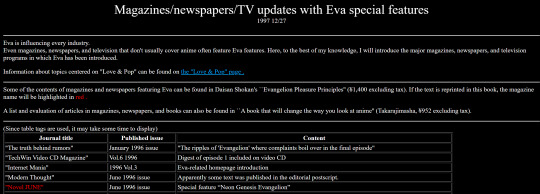
A somehow-still-existing 1997 fan page by a Japanese otaku (I'm giving you this stuff auto-translated btw, what would you do with a wall of kanji?) who extensively catalogued every media mention of Evangelion. I am sure they missed some, but they didn't miss a big one like the Otsuki letter - which we know from the above interview appeared in gigantic newspaper Yoimiuri Shimbun:

This gives us three candidates; given that we know it was written after the finale aired, and that was March 27th, 1996, our most likely candidate is the April 1st essay; I was able to find a secondary source mentioning the review was "immediately" after the finale, so I think that nails it.
Which alas does not bring up anything! Try as I might I cannot find any extant blog post, or scanned image, or long quoted form. But after trying the usual methods I did realize something - unlike my average document hunt, this is Yoimiuri Shimbum, a newspaper, a big newspaper. Which means they probably have their own archive, which I might be able to access. and low and behold, they do! And my university research services actually have an account!!
Incredibly blessed by this stroke of luck, I went digging for everything containing "Evangelion" and "Eiji Otsuka" in 1996, and found it:
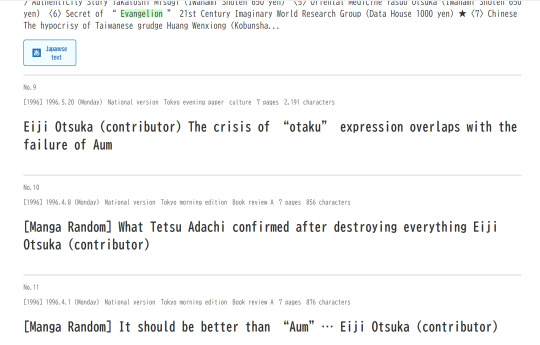
And it's fucking blank. If the article is scanned or anything it will have that "Japanese Text" you see on the first result, or "Scanned Image" tag or something. I swear its like the only ones not scanned, all the random ads and list of best sellers are all there, but the entire cultural essays section is just an archival void. Shot in the skull right at the finish line.
Alas I am out of ideas of this one - its a newspaper, no one is selling this on Yahoo Auctions. Though hey, at least now we know the title:
"オウム」を超えるはずが... / It should surpass Aum...", 876 characters long.
"Aum" by the way is Aum Shinrikyo, the cult terrorist group that conducted the 1995 Tokyo subway sarin gas attack. Which you can imagine really took the chattering classes by storm; it was the culmination of a series of "extremist" actions that began in the 1980's that built up a narrative of societal decay and alarm. It really isn't surprising that Otsuka linked Evangelion to Aum Shinrikyo; the apocalyptic connections were obvious, there was even an episode of the show that had to be changed due to the attacks as the production team thought the events were too similar. And additionally, if this essay was gonna spark a "societal backlash", it has to say something controversial right? I have definitely seen other critics like Hiroki Azuma discussing Eva in relation to Aum as a "social phenomenon" - I am betting Otsuka is the source of that comparison being so ubiquitous.
From other sources like people on twitter and other articles, I can pick up a few other details on what it contained; apparently he referred to Evangelion's finale as a "self-help seminar" for otaku and lambasted the idea of airing one of those on TV. And from his other writings I think you can certainly piece it together - essentially seeing Evangelion's self-involvement and hyper-introspection as a product of the same societal malaise that birthed Aum Shinrikyo, while failing to deliver a solution that could "go beyond" that. Which, the shit you said about media in the 90's, I want a hit of what he's having! But while today its quite obvious that groups like Aum were, sure, saying something about society but turned out overwhelmingly to be fringe weirdos as opposed to canaries in the mental institute coal mine, at the time this was very much the zeitgeist.
Still, I don't really care all that much what it says - its an important artifact! It started the "Eva discourse boom" that broke out of otaku circles and launched Evangelion into a cross-societal phenomenon! We should have a record of it, it should be preserved. I will ruminate on it, and see if any other ideas pop up. And meanwhile if anyone out there happens to see what I missed definitely let me know.
39 notes
·
View notes
Text
Random Ghoulposting: Christianity and Tokyo Ghoul (I promise there's a very tenuous connection)
OK so am I the only person who noticed some weirdly specific parallels between the first arc of Tokyo Ghoul with Anteiku, Kaneki, and Yoshimura, and the books of Acts and Corinthians in the Bible?
Like, there's a guy who absolutely hates a different group and devotes his life to persecuting them, and then ends up having a change of heart and becoming said group's greatest champion (St. Paul; Yoshimura, Kaneki, and Amon).
There's some very specific moral instructions on eating THIS meat, not THAT meat (debate over eating meat sacrificed to idols in Corinthians; Anteiku ghouls trying to subsist on humans who were already dead rather than taking lives).
Said persecutor-turned-champion is trying to get a bunch of angry murderhoboes to stop lying, stealing, killing, cheating, sexing, and otherwise being a moral mess for just ONE SECOND so he can teach them how to live a holy and pure life (the Corinthian church; the Anteiku ghouls).
Also persecutor-turned-champion has a "half-breed" assistant who struggles with his identity but is actually ideally situated to bring together both sides, and will ultimately become his successor (Timothy, who was mixed-race Gentile/Jewish; Kaneki, a half-ghoul).
A lot of flesh vs. spirit angst
"There is no one righteous, not one ... all have sinned, all have fallen short." - Paul of Tarsus, Romans 3:10-11 // "I think if this world is wrong, what's distorting it is everything that is in this world" - Ken Kaneki, Tokyo Ghoul chapter 79
Also fun fact part of the reason the ancient Romans persecuted the Christian church is because they heard all the talk of eating the flesh and drinking the blood of Christ and took it literally and thought the Christians were some sort of weird doomsday cannibal cult.
Granted, I just tend to read way too much Christian symbolism into everything because I am Like That, but the author of Tokyo Ghoul, Sui Ishida-sensei, actually did grow up in a Christian household, which is very unusual in Japan, as stated in an interview here: https://kenkamishiro.tumblr.com/post/177107232612/ishidas-interview-with-yomiuri-shimbun
... so those parallels popping up actually makes a lot of sense. I get the impression based on the storyline of Tokyo Ghoul and his interview remarks that Ishida-sensei suffered some sort of crisis of faith and is more of an agnostic at this point, but it is interesting to think about. He also seemed to imply that the situation of the ghouls in TG and TG:re is somewhat inspired by the historical persecutions or non-acceptance of the Christian minority in Japan.
I know this is going to sound really weird but as a Christian myself, I feel like Tokyo Ghoul has probably helped me think about and even grow in my faith more than most of the Christian fiction I've read. Even though TG's worldview is a lot more morally gray than what I personally try to hold to, and the violence is pretty extreme in places, I think it raises a lot of really interesting questions. And the ultimate message of learning to love your enemies, and live with one's own darker nature in a peaceful way, really resonates with me. Also I just really unreasonably love the story and characters. So ... yeah.
#tokyo ghoul#ken kaneki#st paul#paul of tarsus#sui ishida#bible#corinthians#acts#romans#tokyo ghoul re#christianity#me just digging for christian symbolism in the weirdest places
18 notes
·
View notes
Text
Takarazuka news: two additional follow-ups to the recent investigation report
Following a press conference held by the family of the recently deceased Takarazuka actress, and the company's release of their 3rd-party investigation report, some additional (positive!) updates have made the news:
Takarazuka Revue to survey all 400 actresses via interview, to probe into systematic issues of overwork, etc.
From Yomiuri. Translating select paragraphs that do not repeat already discussed information.
Following the death of a 25 year old member of Takarazuka Revue's Cosmos Troupe, the Revue is launching a fact-finding interview survey targeting all of the company's approx. 400 actresses, with the goal of investigating the problematic issue of systematically imposed excessive work policies, among other things—a company representative tells us. The Revue intends to establish an independent committee that includes outside experts before the end of the year. They intend announce a recurrence prevention strategy based upon the outcome of this study.
On November 14, the Revue published the results of an independent legal investigation conducted in response to the actress's death. The report identifies that based on the accumulation of her activities over an extended period of time, "the possibility that she suffered a severe psychological burden cannot be negated." Revue Chairman Koba Kenshi and other board members acknowledged responsibility and apologized for neglecting their duty to provide a safe and secure work environment, but also stated they were unable to confirm any accusations of bullying or power harassment by senior actresses.
The deceased's family criticized this stance, saying, "We cannot help but call out that [the company's] unquestioned approval of a trend that places excessive importance on hierarchical relationships, and refusal to recognize the actions of the senior actresses as power harassment, shows a thought process rooted in the values of a bygone generation." They are demanding a re-investigation.
Unlike the previous investigation, which focused on the circumstances and causes surrounding the actress's death, this next investigation aims to improve company culture as it relates to excessive work responsibilities and overly extreme leadership.
The Revue will proceed by expanding its interview process to members of the other four troupes—Flower, Moon, Snow, and Star—and will announce its recurrence prevention strategy only after the results have been audited by a third-party legal team.
------
Chairman of Takarazuka's Music School to step down
From Kyoto Shimbun
Following the death of a 25-year-old member of the Takarazuka Revue, Hankyu-Hanshin Holdings president Sumi Kazuo will be stepping down imminently from his position as board chairman of Takarazuka Revue's preparatory academy, Takarazuka Music School, an official source tells us. Newly instated Revue chairman Murakami Kouji is his planned to successor, taking the position as of December 1.
40 notes
·
View notes
Text

From: Onchi. A Poet of Colors and Forms, Yomiuri Shimbun, Tokyo, 1994 [BOOKS at, Amsterdam]
Exhibition: Yokohama Museum of Art, Yokohama, October 8 – November 6, 1994
#graphic design#art#drawing#exhibition#catalogue#catalog#onchi kōshirō#koshiro onchi#yomiuri shimbun#yokohama museum of art#1990s
37 notes
·
View notes
Text

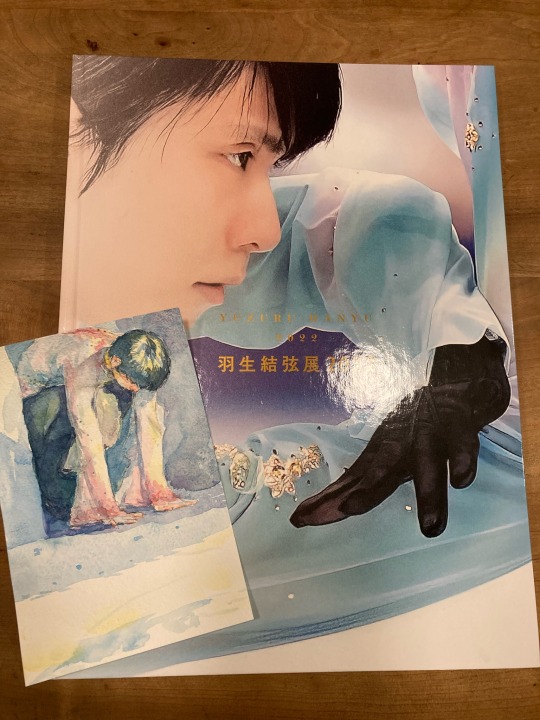
Yomiuri Shimbun and the same corporation are accepting relief funds for victims of the Noto Peninsula Earthquake until February 29th. A portion of the sales of goods will be donated to help with this disaster. I drew this from the photo collection of Yuzuru Hanyu Exhibition2022🙏
31 notes
·
View notes
Text
📕「魔法のルビーの指輪」
(イヴォンヌ・マッグローリー作/ 加島葵訳 /深山まや絵 / 朔北社 )
読売新聞 (2024年8月26日(月)夕刊)に掲載いただきました。
📕”The secret of Ruby ring Japanese Edition”
Written by Yvonne Macgrory
Translated by Aoi Kashima
Illustrated by Maya Miyama
Publisher Sakuhokusha
It was featured in Japanese newspaper The Yomiuri Shimbun (Evening edition, Monday, 26th August 2024).
Thank you so much!

#魔法のルビーの指輪#イヴォンヌマッグローリー#加島葵#深山まや#朔北社#読売新聞#thesecretofrubyring#yvonnemacgrory#aoikashima#mayamiyama#sakuhokusha#theyomiurishimbun
2 notes
·
View notes
Text

Hiroki Nanami [009] and Shunichi Takahashi [002] interview for Theater Girl Part I "Feeling the responsibility of taking on a major role while bearing the pressure of the 60th anniversary performance" Part II “Despite the pressure of playing a major role in the commemorative performance, I still have a sense of responsibility in my heart”

Hiroki Nanami's interview for Yomiuri Shimbun focusing on her portrayal of Joe's loneliness

Hiroki Nanami interview for Yoi Part I "Acting that allows you to express yourself without barriers'' Part II How she overcame her perfectionism during her Takarazuka days by accepting that she was "apparently quite sensitive"

Cyborg 009 The Stage opening night Press Conference & Report
#cyborg 009#cyborg 009 the stage#60th anniversary#cyborg adjacent#this is just a list of recent interviews and coverage
3 notes
·
View notes
Text
Why Japan Loves the Most Controversial Player in Sports Just Because He's Not the Most Controversial
Trevor Bauer's Journey to Yokohama DeNA BayStars is a strange one. Being paid more than twenty million grand by the Los Angeles Dodgers not to play in MLB is not a good verdict for his future.

In a sporting world full of polarizing figures, Trevor Bauer stands out as one of the most controversial players. His on-field talents have been undisputed, earning him accolades and recognition in North America. However, it's his off-field antics that have attracted immense criticism and mixed opinions from fans, media, and even fellow athletes. Despite this, Japan has embraced Bauer with open arms as he signed with the Yokohama DeNA BayStars, a team that does not receive the same backlash for their choice despite having a woman as their President of Operations. This intriguing phenomenon sheds light on the stark contrasts between North American and East Asian baseballing culture.
Bauer's journey to Japan has been riddled with controversy, ranging from his public disputes on social media to the serious allegations of assault and harassment against him, leading to his 200-ish game suspension. While some believe that his actions are unacceptable and unfit for a professional athlete, others argue that his talent should not be dismissed solely due to his personal life. This dichotomy of opinions has fueled heated discussions across the globe.
However, to truly understand Japan's welcoming stance towards Bauer, we must delve into the deeply ingrained cultural differences between the two baseballing cultures. In North America, there is often a focus on individuality and the celebration of personal achievements. Players are often seen as idols and are expected to maintain a certain public image, both on and off the field. As such, when someone like Bauer makes headlines for all the wrong reasons, the backlash can be overwhelming.
Conversely, in East Asian baseballing culture, there is a strong emphasis on the team and collective harmony. Individual players are often seen as contributing to the greater whole, rather than being placed on a pedestal. As a result, controversies involving players, though acknowledged, might not lead to the same level of outrage that they would in North America.
To further contextualize this phenomenon, let's examine the storied history of the Yomiuri Giants, one of Japan's most prominent baseball franchises. The Giants have had a long and tumultuous relationship with controversial athletes, with a history marked by various instances of misconduct. From the infamous "Babygate" incident involving former captain Hayato Sakamoto, to the point that he received close to no backlash, to the trade of Sho Nakata after a violent altercation, it becomes apparent that Bauer's controversies are not unparalleled within the Japanese and the entire East Asian baseball scene.
Even as far back as the early 2000s, Yomiuri's South Korean Pitcher Cho Sung-min faced challenges in his personal life. His turbulent relationship with his wife, actress Choi Jin-sil, became a topic of public scrutiny as he was released by Yomiuri shortly after, leading towards a screeching halt towards both of their careers which ended up leading to the couple separating and committing suicide. This is kind of weird, rather than peculiar, as this case was a significant contrast which emerges when Yomiuri Shimbun was still the leading newspaper in the entire East Asia.
Compared to the media's coverage and public perception of such incidents to the video featuring Bauer's controversial tirades, this is basically comparing apples to pears, which led to the public accepting the pears because the Appletree had been so rotten to the point that the wood is unsuitable for production.
The fact that Bauer was rejected by the Yomiuri Giants due to his controversies might raise eyebrows, considering the franchise's history with controversial athletes. However, it also reflects how individual teams within a league can differ in their approach to handling controversy and protecting their brand image.
As long as the men avoid getting involved in drug-related controversies, East Asian entertainment industries, and presumably sports as well, tend to protect male personalities despite their personal flaws. This is a complex issue that warrants further examination in the context of cultural norms, societal expectations, and the role of athletes as public figures, especially as the East Asian popular culture sphere expanded.
In conclusion, Trevor Bauer's signing with the Yokohama DeNA BayStars and the relative acceptance he has received in Japan despite his controversies shed light on the cultural differences between North American and East Asian base Balling culture. It also highlights the complexities of public perception, media coverage, and how individual teams approach controversial athletes. While Bauer's actions have been divisive, they are not unparalleled within the context of Japanese baseball. This intriguing phenomenon serves as a reminder that the perception of a player's controversies can be heavily influenced by cultural norms and the prevailing sports culture in different regions of the world.
2 notes
·
View notes